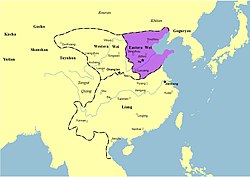Eastern_Wei
Wei (/weɪ/), known in historiography as the Eastern Wei (simplified Chinese: 东魏; traditional Chinese: 東魏; pinyin: Dōng Wèi), was an imperial dynasty of China that followed the disintegration of the Northern Wei dynasty. One of the Northern dynasties during the Northern and Southern dynasties period, the Eastern Wei ruled the eastern part of northern China from 534 to 550. As with the Northern Wei, the ruling family of the Eastern Wei were members of the Tuoba clan of the Xianbei.
